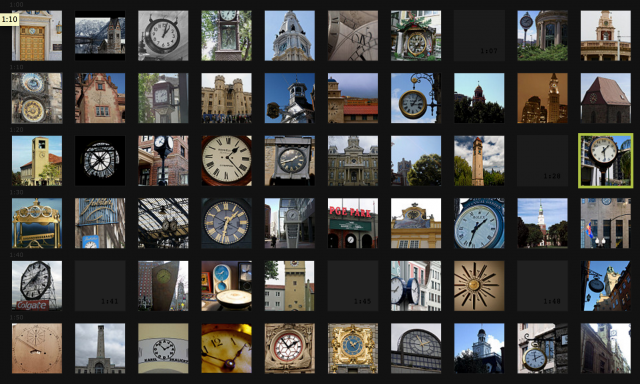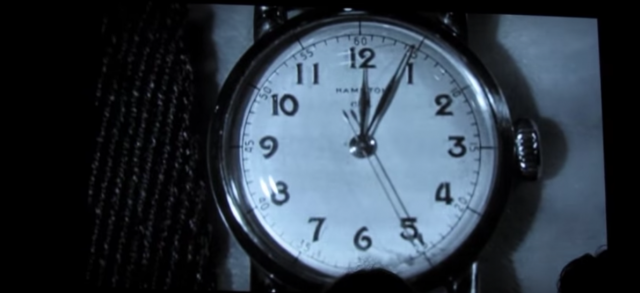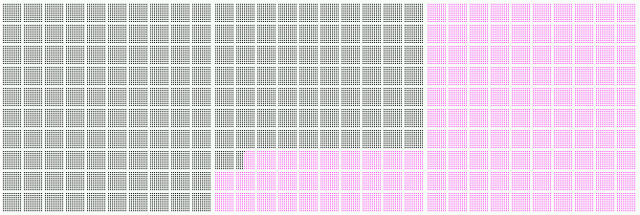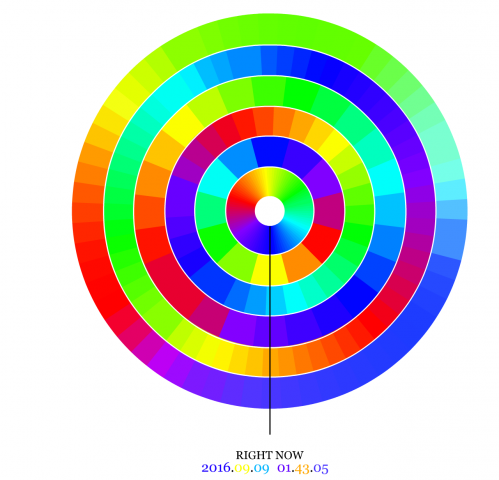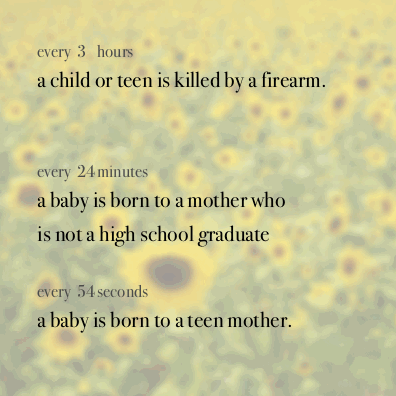Lecture 09-09b: Clocks
Sources for this Lecture
Representing time is an endless fount of innovative inquiry, and a perennial assignment in the media arts. I received the assignment from my teacher, John Maeda, and I now pass it on to you.
In this lecture, we’ll consider alternative representations of time, in history and in the arts. This lecture includes materials from:
- Paolo Pedercini, Visualizing Time
- Joshua Foer, A Minor History of Time Without Clocks
- Andreas Gysin, Design a Clock
Clocks as Performance: Live and Unplugged
Here’s Standard Time, a 24-hour performance by Mark Formanek, in which a clock is rebuilt every minute:
Here’s Sweeper Clock by Maarten Bas, a movie featuring two men with brooms, recorded from above. They continually push lines of debris to form (moving) clock hands.
Pre-Modernity
Joshua Foer has done such an excellent job, it is best just to link to his A Minor History of Time Without Clocks. Here’s a PDF backup. Let’s pay special attention to the following:
- 1600’s Cannon Dial
- 1633 Kircher’s sunflower clock, set by the heliotropism of a flower
- 1728 Sawai Jai Singh’s 90-foot tall sundial, accurate to 2 seconds
- 1733 Moon dial, read by the shadow of the moon
- 1751 Linnaeus’s flower clock, read from the opening of flowers
- 1929 “aktograph”, or bean leaf movement clock
More Thoughts on Clocks
It’s worth remembering that the convention that we use 12 (or 24) hour time is totally arbitrary — an artifact of ancient Egyptian astronomy. Other systems have been used and proposed. For example, until quite recently, a six-hour day was used in Thailand. During the French Revolution, when the metric system was invented, people seriously proposed decimal time. Here’s a decimal clock from the late 1700s:
Crowdsourced Clocks
The Human Clock is a clock made from crowdsourced photographs. The Photo’Clock by Mono-1 is similar.
Another, All the Minutes is a clock comprised of tweets about the current time.
The World Clock Project by Harvest:
A well-known ‘crowdsourced’ clock (in a different sense) is Christian Marclay’s Clock, a 24-hour film made up of about seven thousand clips, each of which either says or displays the (actual) time of day, or which makes a cogent reference to time:
I have a sneaking hunch these clips won’t have a very long lifespan on that video hosting site. Here’s a still image:
Software Clocks
Let’s start with something simple. The Colour Clock displays the current time as a hexadecimal color. Hours = red, minutes = green, seconds = blue. There you go; glad that’s over with. In case you were wondering, more than several people have thought of this idea. Low hanging fruit.
Now let’s go back in history. Here are John Maeda’s 12 O’Clocks from 1996. If the real apps (OS9) don’t work any longer, here’s a video (jump to 4’00”):
Live OS9 demo instructions for Golan:
- Download artwork from http://www.maedastudio.com/2004/rbooks2k/twelve.html
- Unstuff twelve.sit and locate in /Users/Shared/MaedaClocks/12oclocks
- Launch the SheepShaver OS9 emulator, /Users/golan/Desktop/PEDAGOGY/iacd/2015/clocks/COIV4.0.1+/Classic.app
- After OS9 launches, navigate to Unix/MaedaClocks/12oclocks in OS9; demo
- Force-quit SheepShaver to exit.
Here’s an interactive clock (Java applet) I created for John Maeda’s assignment in 1999.

There have been many interesting software clocks since then. Yugo Nakamura’s Industrious Clock (2001) is a classic:
Here is the elegant video-slitscan-based Last Clock, (2002) by Jussi Angesleva & Ross Cooper:

Here is CRASHCLOCK by tha:
Here is Horloge Tactile by Swiss student, Eric Morzier (2005):
Quasimondo’s Clockr no longer seems to be operational, but it used the OneDigit photopool at Flickr…. you can imagine it. Color Clock by Aer Studio can no longer be found online, either.
Another elegant software clock is Dot Clock, by Vendian, which uses one dot to represent every second in the day:
Here’s the simple but effective Polar Clock (live version) by Gabriel Mak:
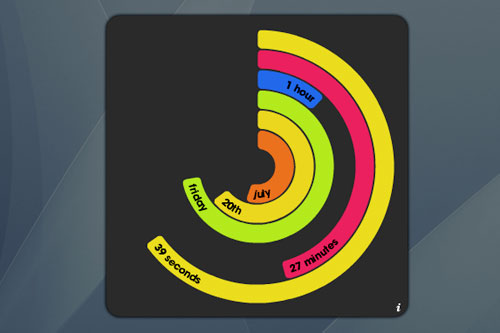
Color and circles, man. Here’s Colhour, by Harald Martin Ström:
A simple rectangular prism clock, hms, by Andreas Gysin:
Here’s a cryptic QR Code Clock.
In Pong Clock, a modified game of Pong by Sander Mulder and Leonardo Lima, two computer-controlled NPC’s constantly score the time.
My student Greg Vassallo made this in 2005 (show Processing applet)
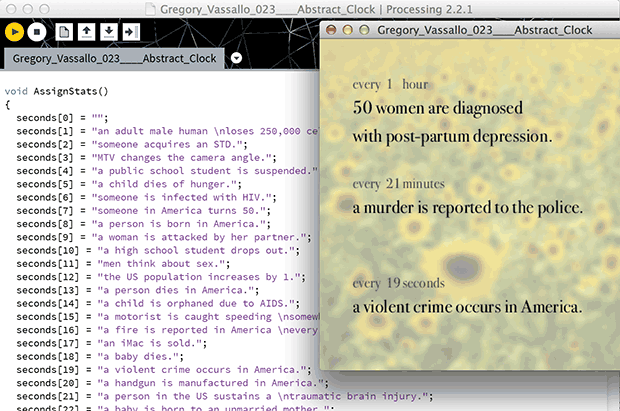
CMU Design student Lee Byron made this, Center Clock (Java applet) in my class in 2006. He recently ported it from Java to p5.js, so it once again works on the web.

The awesome Sonicode Clock by Saqoosha (2008):
And many more lovely generative JavaScript clocks by Vincent Toupe (Procyonic).
Clever New Mechanics
A sundial watch isn’t a crazy idea. Here’s a new version from the creative people at P9:
Many of you probably know DropClock:
Ink Calendar by Oscar Diaz uses capillary action to display the time:
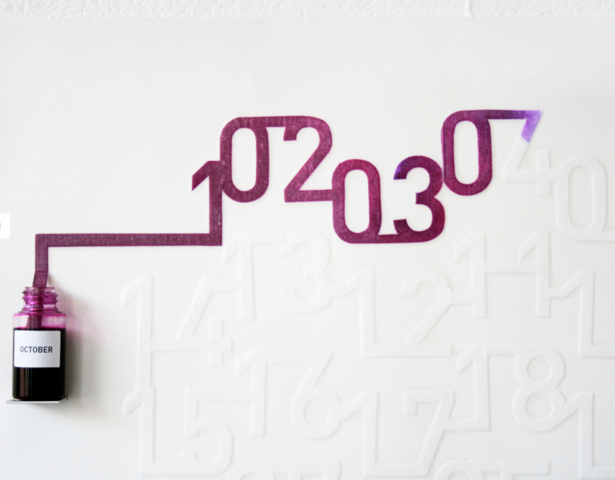
The Clock Clock, by the Stockholm-based designers, HumansSince1982:
These humans aren’t messing around. Here’s their “A Million Times” clock:
Art Lebedev’s Segmentus Clock:
Here is A Study Of Time by rAndom International (2011):
Hans Andersson’s Time Twister (LEGO Mindstorms Digital Clock):
Dave Esty’s This Time Around:
Qlocktwo by Biegert & Funk selectively illuminates parts of a text image:
In this clock designed by Giha Woo and Shingoeun, a single spiraling arm indicates the time in different countries around the world, simultaneously.

Taiwanese designer Yen-Wen Tseng has designed a clock, “Hand in Hand“, where the hands are linked by two more pivoting arms:
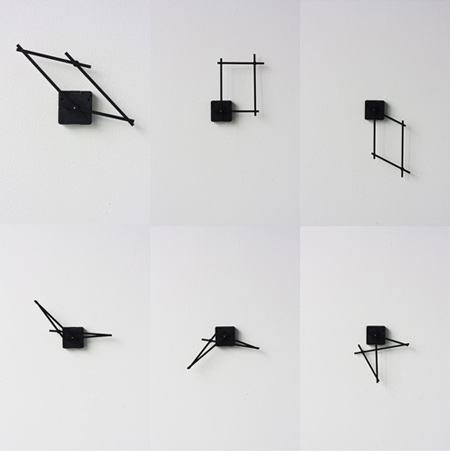
Color O’Clock by Duncan Shotton is attractive, though one wonders why it needs the hands at all:
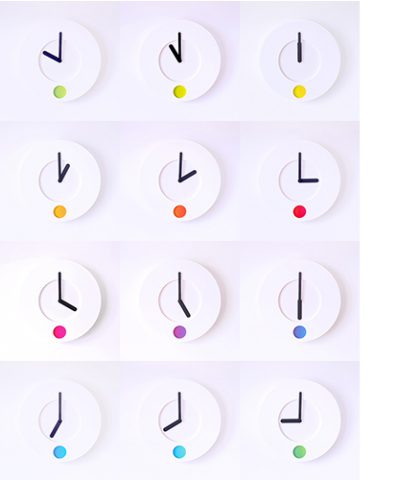
Dutch product designer Sander Mulder has designed a wall clock, Continue Time, with a single, articulated arm that can display hours, minutes and seconds all at once. (Yes, that’s the same Sander Mulder who designed the Pong Clock.) The lightning-shaped mechanical arm continually changes shape over a 12 hour period (jump to 1’00”):
In some situations, it may not be necessary for a clock to “work” mechanically in order for it to “operate” powerfully. Below are clocks which are frozen at 8:15am, the moment when the Hiroshima bomb detonated, when Kengo Nikawa’s pocketwatch stopped forever.

In another situation, a clock may simply be working so slowly that it never appears to be working in our lifetime. The Clock of the Long Now, designed to last 10,000 years, ticks once per year and chimes once per century. As such, it fosters long-term thinking and remains an important symbol of hope for the future.



